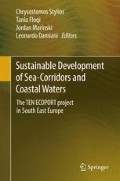Abstract
Managing coastal development requires a set of tools to adequately detect ecosystem and sediments degradation. Benthic indicators are often used to detect or assess disturbances, but while they may be very sensitive to the impact itself, the question is whether they can be used as a complementary tool for port managers to improve the environmental policy. The chapter is focused on environmental assessment of influence of Constanta and Mangalia ports’ activities on the macrobenthic diversity and population structure. Using the diversity and ecological quality indices as tools for quantifying the Good Environmental Status of the area situated in the proximity of the ports, our main results revealed a positive correlation between shifts occurred in macrobenthic population structure and distance to ports aquatorium. It showed also notably different temporal trends, indicating the high sensitivity to environmental pressures.
Access this chapter
Tax calculation will be finalised at checkout
Purchases are for personal use only
References
Borja A, Franco J, Perez V (2000) A marine biotic index to establish the ecological quality of soft-bottom benthos within European estuarine and coastal environments. Mar Pollut Bull 40:1100–1114
Clarke KR, Warwick RM (2001) Change in marine communities. An approach to statistical analysis and interpretation, 2nd edn. Primer-E, Plymouth
ESPO-ITMMA (2007) ESPO annual report 2006–2007. http://www.espo.be/. Accessed 20 March 2014
Glémarec M, Hily C (1981) Perturbations apportées à la macrofaune benthique de la baie de Concarneau par les effluents urbains et portuaires. Acta Oecol Oec Appl 2:139–150
Gray JS, Clarke KR, Warwick RM et al (1990) Detection of initial effect of pollution on marine benthos: an example from the Ekofish and Eldfish oilfields, North Sea. Mar Ecol Prog Ser 66:285–299
Guerra-García J, García-Gómez JC (2004) Polychaete assemblage and sediment pollution in a harbour with two opposing entrances. Helgol Mar Res 58:183–191. doi:10.1007/s10152-004-0184-4
Halpern BS, Selkoe KA, Micheli F et al (2007) Evaluating and ranking the vulnerability of global marine ecosystems to anthropogenic threats. Conserv Biol 21:1301–1315. doi:10.1111/j.1523-1739.2007.00752.x
Ingole B, Sivadas S, Nanajkar M et al (2009) A comparative study of macrobenthic community from harbours along the central west coast of India. Environ Monit Assess 154:135–146. doi:10.1007/s10661-008-0384-5
Kröncke I, Reiss H (2010) Influence of macrofauna long-term natural variability on benthic indices used in ecological quality assessment. Mar Pollut Bulls 60:58–68. doi:10.1016/j.marpolbul.2009.09.001
Mandal S, Harkantra SN (2013) Changes in the soft-bottom macrobenthic diversity and community structure from the ports of Mumbai, India. Environ Monit Assess 185:653–672. doi:10.1007/s10661-012-2582-4
Muxika I, Borja A, Bald J (2007) Using historical data, expert judgement and multivariate analysis in assessing reference conditions and benthic ecological status, according to the European water framework directive. Mar Pollut Bull 55:16–29. doi:10.1016/j.marpolbul.2006.05.025
Nicolaev S, Zaharia T, Lazar L et al. (2012) Report on the state of the Marine and Coastal Environment in 2011. Cercet Mar Rech Mar 42:5–92
Secrieru D, Oaie G, Gomoiu MT et al (2011) Monitoringul geoecologic al platoului continental românesc. Report. NIRD GeoEcoMar
TEN ECOPORT (2014) http://www.tenecoport.eu/index.php/partners/erdf-partners. Accessed 5 April 2014
Venturini N, Muniz P, Rodríguez M (2004) Macrobenthic subtidal communities in relation to sediment pollution: the phylum-level meta-analysis approach in a south-eastern coastal region of South America. Mar Biol 144:119–126. doi:10.1007/s00227-003-1186-5
Acknowledgments
The authors acknowledge support funded by the SEE Programme—TEN ECOPORT Project and EU FP7 HYPOX.
Author information
Authors and Affiliations
Corresponding author
Editor information
Editors and Affiliations
Rights and permissions
Copyright information
© 2015 Springer International Publishing Switzerland
About this chapter
Cite this chapter
Teaca, A., Begun, T., Muresan, M. (2015). Assessment of Soft-Bottom Communities and Ecological Quality Status Surrounding Constanta and Mangalia Ports (Black Sea). In: Stylios, C., Floqi, T., Marinski, J., Damiani, L. (eds) Sustainable Development of Sea-Corridors and Coastal Waters. Springer, Cham. https://doi.org/10.1007/978-3-319-11385-2_7
Download citation
DOI: https://doi.org/10.1007/978-3-319-11385-2_7
Published:
Publisher Name: Springer, Cham
Print ISBN: 978-3-319-11384-5
Online ISBN: 978-3-319-11385-2
eBook Packages: Earth and Environmental ScienceEarth and Environmental Science (R0)

